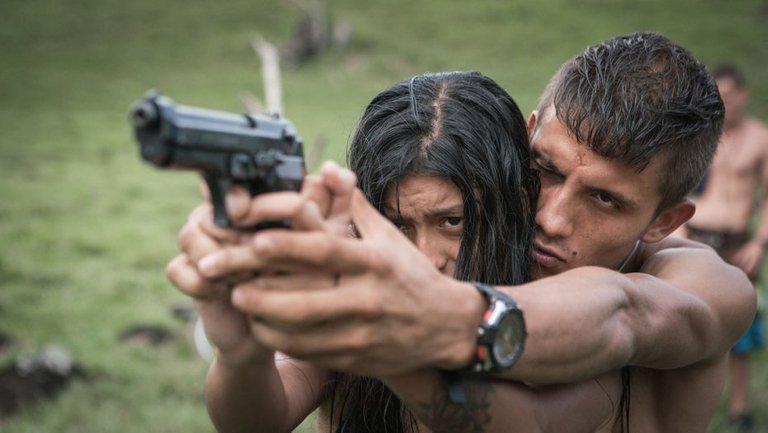Laura Mora’s sophomore outing, a real-life revenge drama set in Medellin, played in San Sebastian’s New Directors sidebar and took two awards.
Killing Jesus must have been a tough film to make for the Colombian Laura Mora, whose own father, like her heroine’s, was shot dead by a hitman — whom, like her heroine, she later met. But far from being a straight-up good vs. bad revenge drama, Mora has wisely reserved her anger not for the killers, but for the kind of society that turns people into killers. Thus simmering with controlled bitterness, Jesus has an intensity and rawness that more than make up for its flaws. Further festival killings are likely, following outings at Zurich, Toronto and San Sebastian.
At the start, Paula (Natasha Jaramillo, like most of the rest of the cast a non-pro) is a carefree arts student, full of laughter, attending student meetings, snapping photos, smoking too much dope and protesting against the system. In this, she’s following in the footsteps of her father Jose Maria (Camilo Escobar), a teacher/lawyer who exhorts his students to “never stop asking questions." This is a dangerous strategy in a Medellin where people can be killed for saying the wrong thing in public, and indeed practically every time the radio or TV is on, someone is talking about socio-economic difficulties in Colombia.
One afternoon while he’s driving Paula home, in an explosively filmed scene Jose Maria is shot dead from the back of a motorbike; Paula glimpses the face of the sicario as he makes his escape. Together with her brother Santiago (Juan Pablo Trujillo) Paula dutifully recounts all this to the police. But right down to the fact that the cops have stolen Jose Maria’s watch, it’s pretty clear that they’ll be no help at all.
All gaiety gone, Paula is now an embittered, driven figure. Across the crowded floor of a night club, she spots her father's killer, Jesus (Giovanny Rodriguez, in a performance that takes "brooding" to a whole new level) and makes the decision to enact her revenge. But getting hold of the gun to do so is no easy matter unless you have the cash, and the middle part of the film charts Paula’s sometimes awkward attempts to enter Jesus’ world while getting hold of the murder weapon.
The script is not always elegantly turned. Tiago, for example, suddenly and inexplicably completely disappears from things after blowing up at Paula in a scene which seems to derive from the tradition of over-the-top Latin American soap operas, while the question of who might have ordered the killing and why, which you might have expected to be uppermost in Paula’s mind, is broached too briefly.
But there are also several touches of real insight. The fact that both Jose Maria and his killer are afraid of having their photograph taken is a beautifully concise way of suggesting that they tragically share a worldview dominated by fear. Equally sharp-eyed is a potent, scary scene where the vulnerable Paula finds herself on a lonely hillside surrounded by violent, hormonal young men, vomiting after Jesus has tried to teach her how to fire a gun. “Don’t be scared,” he chillingly advises her. “Without hatred, nothing happens.” The scene has a power and compactness that is lacking from some sequences and raises the question: Does Paula hate Jesus enough?
What’s not lacking from Killing Jesus is in-your-face naturalism, delivered via urgent, sometimes shaky hand-held camera. As the director herself admits, the work of Colombian maestro Victor Gaviria, director of the hyperrealist Rodrigo D and The Rose Girl, shadows the film throughout. Like Gaviria, Mora uses non-professional actors and is careful to fill her frames with the “authentic” Medellin of the backstreets, where the gangs live in uneasy fear of one another, where Latino rap and salsa are ever present, where machismo is rife and where, cliches apart, life really does seem to be too cheap. The plot is put together with more contrivance than in Gaviria, but at times Jesus does achieve a similar kind of delirious intensity in its wonderful portrayal of Medellin’s surreal street chaos.
And like Gaviria, Mora ekes a little poetry out of all the violence. Some of Jesus’ strongest scenes feature memorable slow-motion shots of street kids on motor bikes and bicycles, as though in recognition that they too are victims, in search of a little romantic release. And one scene toward the end, featuring Lita and Jesus in an imagined embrace against a backdrop of backstreet squalor, with flickering neon lights behind them, is perhaps the film’s strongest, because quietest, moment — the one where Paula realizes that even her father’s killer might be worthy of some kind of redemption. For a director who has herself suffered her heroine’s parental loss, to be capable of expressing such empathy via a cinema screen is a notable achievement.
Production companies: 64-A Films and AZ Films
Cast: Natasha Jaramillo, Giovanny Rodriguez, Camilo Escobar, Carmenza Cossio, Juan Pablo Trujillo, Jose David Medina, Juan Camilo Cardenas.
Director: Laura Mora
Screenwriters: Laura Mora, Alonso Torres
Producers: Diego F. Ramírez, Alex Zito, Ignacio Rey, Juan Pablo García, Maja Zimmermann
Executive producers: Nancy Fernandez, Pola Zito, Javier Del Pino
Director of photography: James L. Brown
Art Director: Iris Ocampo
Costume Designer:Adriana Gallego
Editor: Leandro Aste
Composer: Sebastian Escofet
Venue: San Sebastian International Film Festival (New Directors)
Sales: Latido Films
comment back done
Hi! I am a robot. I just upvoted you! I found similar content that readers might be interested in:
http://www.hollywoodreporter.com/review/killing-jesus-review-1046603